This article originally covered the mid-2020 launch of the Lenovo Legion Slim 7, which eventually never arrived in stores.
In the meantime, though, as of early-2021, Lenovo announced the updated Legion Slim 7, similar to the 2020 model in many ways, but with some slight refinements and this time built on 2021 hardware: AMD Ryzen 5000 processors and Nvidia RTX 3000 graphics.
Lenovo have yet to provide the full picture on this new Slim 7, except for a couple of blurbs of information and some renders, so stick around as we’re filling up the blanks here.
From what we know so far, this Legion Slim 7 is a compact and slim 15-inch laptop that weighs around 1.9 kilos (4.2 lbs) and is entirely crafted out of magnesium and aluminum alloys. This time it also comes in a Shadow Black color variant, alongside the standard Storm Grey color normally offered with Legion 7 models in recent years.
Update: Our full review of the Legion Slim 7 series is available over here.
Update2: Updated 2022 Legion Slim 7 models are available now, with faster hardware, larger batteries, and 16:10 displays. Our detailed review of the 2022 Lenovo Legion Slim 7i series is available here.
Update3: And here’s our coverage of the 2023 Lenovo Legion Slim 7 series, with updated specs and higher-power settings.
It also gets a white or RGB-lit Corsair iCUE full-keyboard with a NumPad section, and a larger glass clickpad than any Legion before, plus a camera at the top of the screen, a quad-speaker system, and the IO lined around the sides. I’m looking at USB-C slots on the right side, a full SD card reader and the audio jack on the right, and the PSU and two USB-A slots on the back. That’s similar to the Slim 7 announced in September 2020, but with some design changes around the exhausts and what looks like an even smaller footprint, judging by the size of the bezels around that screen.
Speaking of the screens, Lenovo mentioned two options for this series: a fast QHD 165Hz panel with 3 ms response and 100% sRGB colors, as well as a 4K 60 Hz with 100% AdobeRGB, as a premium option for creators. Both are 15.6-inch 16:9 IPS.
This aside, the press info also mentions an updated Coldfront 3.0 thermal design, with two fans and quad-radiators, as well as liquid metal applied to the processor.
The 2021 Lenovo Legion 7 Slim series is built on Ryzen 5000 and RTX 3000 hardware, with a 71 Wh battery and hopefully dual RAM slots and dual M.2 SSDs. That’s yet confirmed and based on the specs of the original Slim 7 launched last year.
The official specs don’t mention whether we’re looking at Ryzen 9 H 45W or HS 35W processors, or the exact kind of graphics, but an AMD Ryzen 9 5900HS with an RTX 3060 dGPU (probably MQ) would make the most sense to me in this sort of a chassis. Update: THis has been confirmed with 45W Ryzen processors, up to Ryzen 9 5900H, and an RTX 3060 MQ dGPU.
Competent performance/noise profiles, ActiveSync, and Dynamic Boost technologies meant to divert power between the CPU and GPU based on loads should make it into this flagship product.
| 2021 Lenovo Legion Slim 7 – review | |
| Screen | 15.6 inch, matte, non-touch, FHD 165 Hz 3ms with 300-nits, 100% sRGB 15.6 inch, matte, non-touch, UHD 60 Hz with 600-nits and VESA HDR 400, 100% Adobe RGB |
| Processor | AMD Cezanne Ryzen 5000 CPU, up to Ryzen 9 5900H 8C/16T or 11th gen Intel Tiger Lake H might be available later on |
| Video | up to Nvidia RTX 3060 Laptop Max-Q |
| Memory | up to 32 GB DDR4 3200 MHz (2x DIMMs) ?? |
| Storage | 2x M.2 SSD ?? |
| Connectivity | Wireless 6 AX, Bluetooth 5.1 |
| Ports | 2x USB-A 3.2 gen2, 2x USB-C (on Intel models), card-reader, mic/headphone |
| Battery | 71 Wh, up to 230W power brick and USB-C charging up to 100W |
| Size | – |
| Weight | from 1.9 kg (4.2 lbs) |
| Extras | White or optional Corsair TrueStrike RGB backlit keyboard, webcam, Dark Shadow and Slate Gray colors, magnesium/aluminum build, quad speakers ?? |
That’s about what we know of this 2021 Slim 7 series for now. Oh, and it’s also scheduled ins stores around May 2021, at yet undisclosed pricing. So if you’ve been waiting for this for a while, as I know some of you have, tough-luck, it’s still several months out of reach.
I’m quite excited about this myself, and I’m seeing it as a more powerful alternative for the ThinkPad X1 Extreme, with beefier AMD hardware and graphics. Not a big fan of the full keyboard layout, but it does otherwise seem to tick all the other right boxes. Judging by the popularity of the X1E series, I’d expect this to attract its own crowd, when eventually available.
— Original article —
Lenovo sell some of the best-value performance/gaming laptops available these days with their Legion 5 and 7 series, yet those are full-size laptops and might not always cater to potential buyers that are looking for something perhaps not as powerful, but lighter and easier to grab along.
If that’s you, then these newer Lenovo Legion Slim 7s models that are scheduled for release in this last quarter of 2020 might be of interest.
In just a few words, these are slimmer and lighter iterations of the popular Legion 7, with still powerful hardware specs, long battery life, and solid screen options. They do compromise to some extent on the hardware specs, IO, and thermal design compared to the full-size Legion 7, though, aspects that need to be balanced out by the more portable form-factor.
This clip down below quickly compares the Legion Slim 7 to the regular Legion 7, so you’ll know what to expect in terms of design, IO, inputs, and technology when opting for one over the other. It’s about the Intel-based Legion Slim 7i, but most of it also applies to the AMD-powered Slim 7 as well. We’ll get to that in a bit.
Then, here’s a quick specs sheet of the Legion Slim 7 lineup next to the standard Legion 7, and we’ll dive into some details further down.
| 2020 Lenovo Legion Slim 7 | 2020 Lenovo Legion 7i | |
| Screen | 15.6 inch, matte, non-touch, FHD 144 Hz 5ms with 300-nits, 100% sRGB 15.6 inch, matte, non-touch, UHD 60 Hz with 600-nits and VESA HDR 400, 100% Adobe RGB |
15.6-inch, matte, non-touch, FHD 144 to 300Hz 3ms, 100% sRGB, 500-nits |
| Processor | AMD Ryzen 4000 CPU, up to Ryzen i9 8C/16T or 10th gen Intel Comet Lake Core H CPU, up to Core i7 6C/12T |
10th gen Intel Comet Lake Core HK CPU, up to Core i9 8C/16T |
| Video | up to Nvidia RTX 2060 Max-Q, with Optimus | up to Nvidia RTX 2080 Super Max-Q, with NVIDIA Advanced Optimus/G-SYNC |
| Memory | up to 32 GB DDR4 3200 MHz (2x DIMMs) | up to 32 GB DDR4 3200 MHz (2x DIMMs) |
| Storage | 2x M.2 SSD | 2x M.2 SSDs with RAID support |
| Connectivity | Wireless 6 AX, Bluetooth 5.0 | Gigabit LAN, Wireless 6 AX, Bluetooth 5.0 |
| Ports | 2x USB-A 3.2 gen2, 2x USB-C with Thunderbolt 3 (on Intel models), card-reader, mic/headphone | 3x USB-A 3.1, 1x USB-C with Thunderbolt 3, 1x USB-C, HDMI 2.0, LAN, mic/headphone |
| Battery | 71 Wh, up to 230W power brick | 80 Wh, up to 280W power brick |
| Size | 356 mm or 14.02” (w) x 250 mm or 9.84” (d) x 17.9 mm or .7” (h) | 360 mm or 14.19” (w) x 255 mm or 10.03” (d) x 19.9 mm or .78” (h) |
| Weight | from 1.8 kg (3.96 lbs) | from 2.1 kg (4.6 lbs) |
| Extras | White or optional Corsair TrueStrike RGB backlit keyboard, webcam, Slate Gray color, fully metallic build, quad speakers | Corsair TrueStrike RGB backlit keyboard with 1.3 travel, RGB light bars, webcam, Iron Gray color, fully metallic build, quad speakers |
Ok, it’s obvious that while the Legion 7i is primarily a gaming laptop with those screen and GPU options, as well as the Advanced GSync support, the Legion Slim 7 is more of a multi-purpose laptop and a powerful notebook targeted at creators/editors/professionals on the go. It’s the only one of the two to offer an SD card reader or a UHD screen option with 100% AdobeRGB color coverage, and is also the only one available with a choice of either Intel or AMD hardware.
That aside, the Legion Slim 7 is .3 of a kg lighter and slightly smaller and thinner than the full-size Legion 7, and with the less powerful hardware, it also ships with a smaller power brick, something else to consider when carrying the laptop around every day.
On the other hand, the standard Legion 7 has its own share of advantages, such as the faster screen options and more powerful GPU choices, the dual-storage with RAID support, the more complex IO, and the larger battery, among others, as well as what I expect to be a more capable thermal implementation with the vapor-chamber design. This is especially something to look for in the detailed reviews of this Slim 7 version, which implements a more standard thermal module similar to what we’ve seen in the Legion 5.
Sure, that only needs to cope with a 65W dGPU, but still needs to cool the power-hungry processors in this space-constrained chassis.
And here’s where we get to what;s perhaps the most interesting part of this Legion Slim 7: it’s one of the very few compact laptops built on AMD Ryzen 4000 hardware, with up to a Ryzen 9 4900H processor at the very top.
So far, the Asus ROG Zephyrus G15 was the only other such available laptop that I can think of, but with its own share of compromises, as that is an older 2019 chassis updated to 2020 hardware. Sure, there’s also the Zephyrus G14 out there, but that’s a smaller screen model. In comparison, Lenovo had a lot more time on their side to put up a better-balanced product that can hopefully tame that Ryzen 9 processor and mid-range Nvidia GPU the right way.
As for the Intel-based configurations, those can be specced up to an Intel Core i9-10980HK processor with the same kind of Nvidia graphics, but Comet Lake is more power-hungry and less efficient than the AMD platform, and should be your choice only if you’re primarily looking to run workloads that would benefit from some of Intel’s design particularities and superior single-core performance. Otherwise, I’d recommend going with AMD.
One thing to keep in mind, though, is that Lenovo mentions that they’ve implemented the Max-Q Dynamic Boost technology on the Nvidia GPUs, which allow the system to increase the GPU’s allocated power by up to 15W when needed, while subtracting it from the CPU. That means more power can be allocated to the GPU in games, which could push the 65W 2060 in these laptops to perform closer to a full-power 80W 2060 implementation. However, what I don’t know at this point is whether this is properly supported by both the Intel and AMD variants, or is just something reserved for the Intel configuration.
Nonetheless, we should have our answers shortly, as the Legion Slim 7 should go on sale in late October 2020, starting at $1369 for the AMD model and $1349 for the Intel versions.
Image credit: This video made by Hardware Canucks on Youtube.

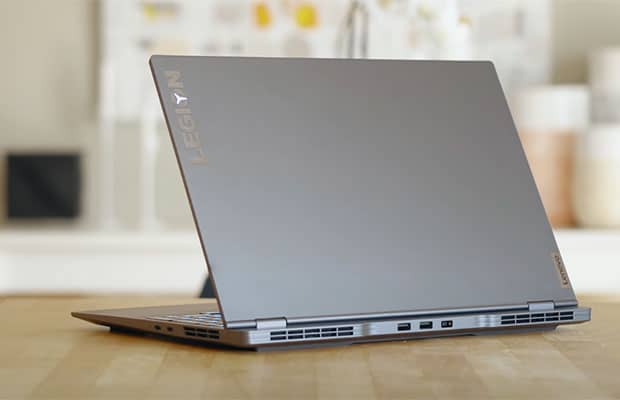
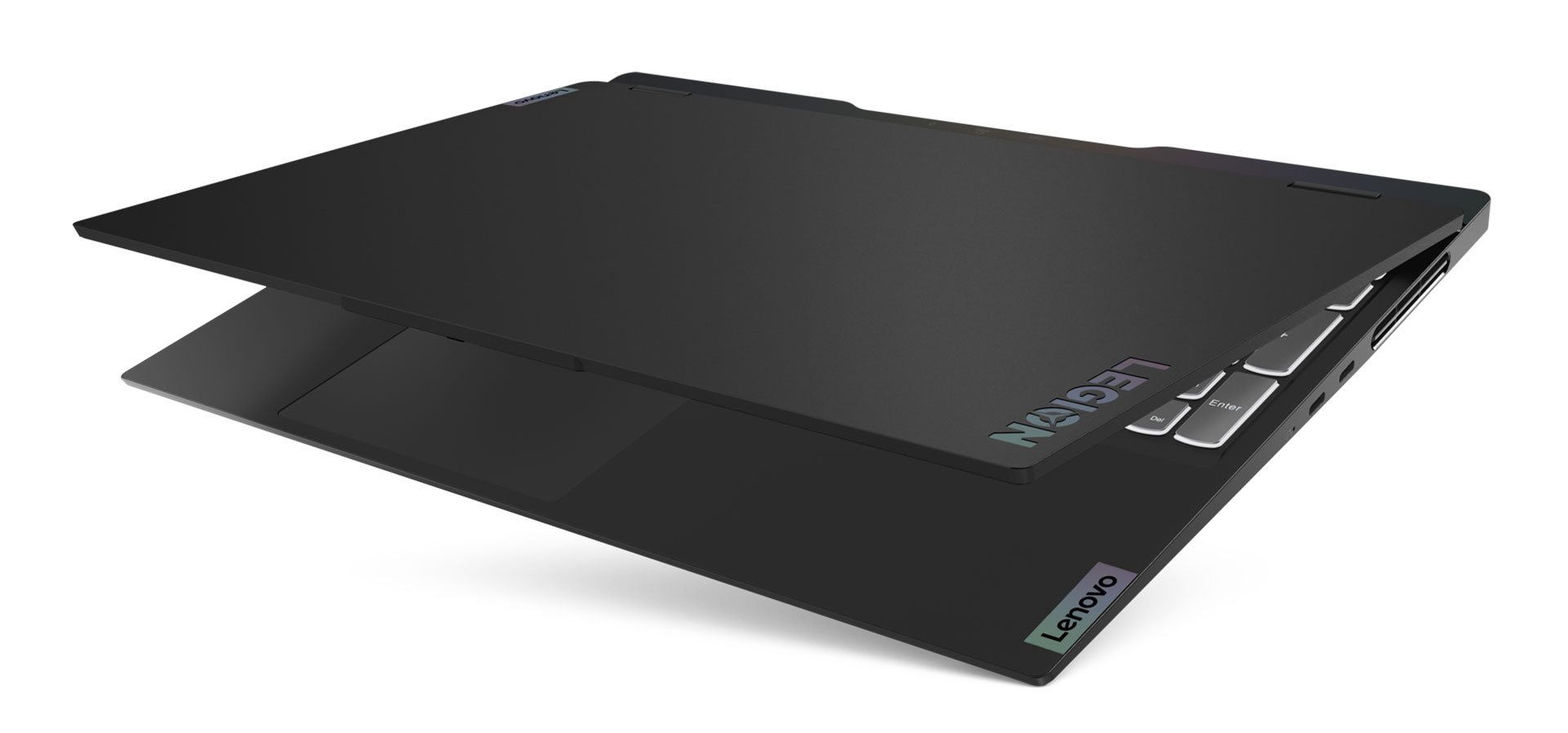
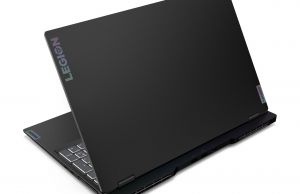
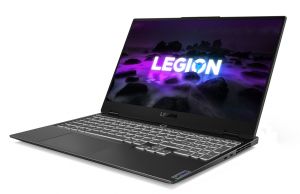
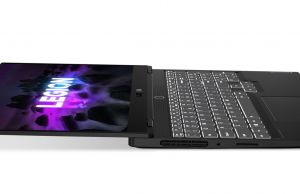

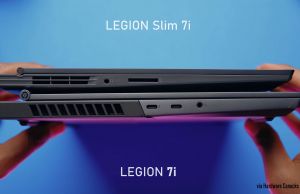
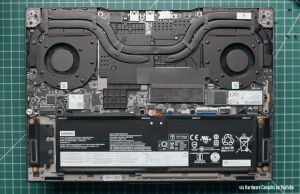
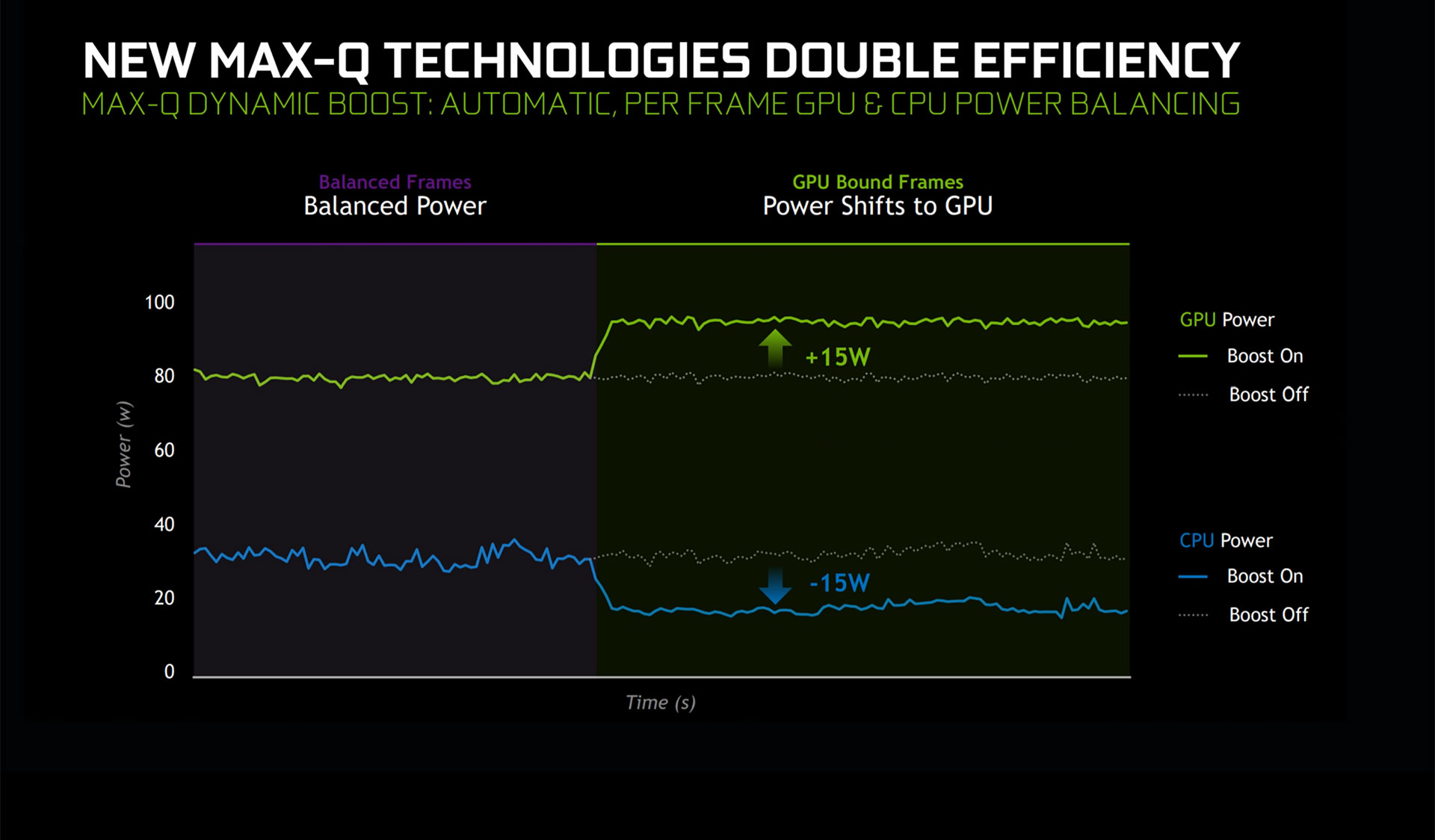

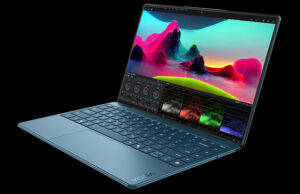
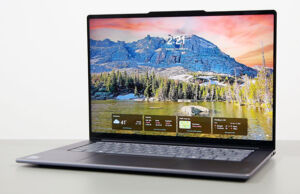
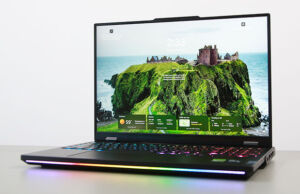

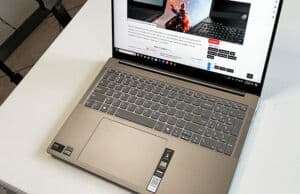





Gil
October 30, 2020 at 5:01 pm
Can it be charged with USB C like the Zephyrus G14?
Andrei Girbea
October 30, 2020 at 5:39 pm
Pretty sure it can, since it also offers Thunderbolt ports.
Ben
October 30, 2020 at 11:35 pm
My big rant about thin and light laptops is this: I couldn't care less about thinness, I only care about weight. Give me some empty space in there for cooling and let travel! Obviously there is a correlation between thinness and lightness because of structure and materials, but it's far from a simple relationship and there has been far too much emphasis on the thinness side, in my book. I'm convinced the whole thinness game is a nefarious plot by Intel.
All that aside, this looks like a good laptop! UHD screen plus less/no RGB are big plusses. Wish there was another SSD slot though.
Andrei Girbea
October 31, 2020 at 10:14 am
I agree, I couldn't care less about a 2-4 mm difference in thickness and I'd rather have something around 20 mm with proper cooling. Hopefully, they didn't cut any corners here, the thermal module seems similar to the one on the Legion 5 which does an excellent job handling a Ryzen processor and 50W GPU in the GTZ1650TI configuration that I've tested.
Sid
March 12, 2022 at 3:52 pm
Hello andrei.
I have a buyer's question. Which would be better for a daily driver as this wouldl be my only pc. Which has better build?
2021 G15(qhd 165hz screen,5900HS and 3060)
or The 2021 legion slim 7(qhd 165hz screen,5800H and 3060)
Rest of the specs are same.
Andrei Girbea
March 14, 2022 at 10:24 am
I preffer the design on the Legion Slim 7 becuase it doesn't blow the hot air into the screen. However, the IO, typing experience, screen quality, and the overall performance are clearly in favor of the G15. The specs might seem similar, but look into the reviews, they are not.
Mrmann
October 31, 2020 at 8:00 pm
Since neither of them offer thunderbolt ports I'd say you're flat out wrong Andrei
Andrei Girbea
October 31, 2020 at 8:14 pm
What do you mean by "neither of them"? As far as I can tell there's TB3 on both Intel variants, but of course, not on the AMD Model. However, that doesn't mean that won't support charging via USB-C
Mr Mann
October 31, 2020 at 8:05 pm
Why are you talking about dynamic boost? It's not available on ANY non-super based laptops. The Ryzen version is a base 2060MQ no dynamic boost or advanced optimus are available on that chipset.
No Ryzen laptop has thunderbolt at this time either.
Andrei Girbea
October 31, 2020 at 8:16 pm
OK, are you sure about that? Lenovo claim that they are using Dynamic Boost and Advanced Optimus on this Slim 7 with the 2060 MQ.
Bobby
November 1, 2020 at 4:11 am
It definitely supports USB-C charging as I saw it somewhere. Also I think dynamic boost only working on the intel variant is a shame as I think this will be most beneficial on an AMD laptop where reducing power to the CPU won't affect framerate as much. Maybe this laptop could have got a 4800HS and full rtx 2060 instead for the AMD version. Another annoyance is no 500 nit 1080p option!!! Battery life also doesn't seem to be great if they are only predicting 10 hours and that means real world use is probably 5 hours. Meanwhile g14 gets solid 10 hours of battery.
Andrei Girbea
November 1, 2020 at 9:12 am
Looks like Ryzen HS hardware is still only available in the ROG Zephyrus models for now, but yes, that HS + 80W 2060 would have sense.
As for battery life, this Yoga and the G14 should be fairly close, there's a 71Wh battery here, 76 Wh in the G14. Sure, the G14 gets the HS hardware and smaller screen, but overall I'd expect perhap0s a 20% difference between them in terms of battery life. For what is worth, though, I never got 10 hours of actual daily use from the G14, more like 5-7 hours. So 4-6 hours on this Legion sounds about right.
Bobby
November 1, 2020 at 12:52 pm
Unfortunately I need battery life of 9-10 hours. I guess we have a few more years to go before that's possible. I think it's best for me to stick with separate gaming laptop and ultrabook for now I guess as I would be missing out on touchscreen as well.
Andrei Girbea
November 1, 2020 at 6:15 pm
But what ultrabook gives you 9-10 hours of real use?
Bobby
November 1, 2020 at 9:16 pm
The Lenovo Yoga C940 with FHD display does. I think the yoga slim 7 AMD does even better
Jeff
November 1, 2020 at 10:37 pm
The predecessor to this laptop, Y740 had touchpad buttons which I loved. They removed the buttons for this generation which is why I won't be getting it.
Max
November 10, 2020 at 12:01 am
How many SSD slots does this computer have? In the internal photo, it looks like there is a second M2 slot next to the battery, but the specs listed here only note one.
Andrei Girbea
November 10, 2020 at 11:04 am
Two slots. Sry for the mistake in the specs list.
Alice
November 18, 2020 at 8:07 pm
I can’t find it online anywhere. When will it be released?
Brandon
December 4, 2020 at 2:11 am
Beginning of December and still not released.. any idea what the hold up is and when I will actually hit the market?
Andrei Girbea
December 4, 2020 at 10:16 am
Sry, but I don't have any inside information. Could be shortages with AMD silicon
wck
January 12, 2021 at 11:06 pm
100w pd only
Benson
May 11, 2021 at 9:06 pm
Waiting and waiting for this
Eddie
May 15, 2021 at 5:18 pm
Hey Andrei, have you heard any updates to the screen specs on the 2021 slim 7 AMD? The CES spec sheet spelled out fhd 1080p 300 nits and 4k UHD 60hz. Do you know if Lenovo has changed to QHD 1440p and upped the brightness to say 500 like the legion 7 full size? This model may be perfect if they can achieve 500 nits on QHD panel but 300 would be too dim I feel. Based on their official pdf, it didn't look like a QHD was announced though.
Andrei Girbea
May 17, 2021 at 10:36 am
Good question, but sry, I don't have any updates for you. I don't have any inside info with Lenovo so I have to rely on the same kind of info that's available for everyone